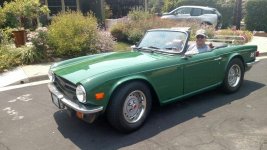…Last time I checked an "orbit" is circular. I still do not understand how a circular arc by a power tool is different than a circular arc by hand and block. Are you saying the size of the circles makes a difference? I look at it from the opposite perspective, in that it is not impossible for one's hand to duplicate the power tool, but rather the power tool can never entirely duplicate one's hand.
Maybe I’m confusing things a little with the way I use the term “circular.” Being sort of OCD I think of textbook mathematical circles, very round things with a single, constant radius, or at least something very close to that.
Pointless side note: (sorry if this just adds confusion, but I can’t help myself) planetary orbits are elliptical. They have two radii. They are only circular in then special case where the radii are identical (which doesn’t happen in nature).
Anyway, the DA’s “orbit” is a spirograph pattern. If you consider the flowers generated by a spirograph to be circles, that’s OK. But whatever you call them, when you make them with sandpaper they aren’t just planform patterns. They’re 3D structures.
The whole point is consistency. A uniform structure can be removed with a uniform process. If the structure is uneven the removal process will need to cover a greater range of structures. With a buffing process, having to cover a wider range of structures means more work and more opportunities to miss deeper defects. You get a cycle of work, inspection and re-work with more instances of residual defects.
A human hand can’t replicate its own motion from one movement to the next, let alone thousands in a row. The resulting scratch pattern is far less consistent than produced by the machine.
One of the worst side effects of circular hand sanding is that the scratch left by subsequent sanding steps looks the same as the previous steps’ that were supposed to be removed. You can’t really tell if you’ve successfully removed the defects from earlier sanding steps until you start buffing and find the scratches aren’t coming out as fast as you expect (or at all).
With linear hand sanding in alternating directions you can see when you’ve removed the previous steps’ defects. Machine sanding produces a pattern that is so consistent that you can also see if the previous steps were removed. But most importantly, due to the uniformity of pressure throughout the entire arc, machine sanding produces a shallower structure that’s easier to remove.
I think we both have different definitions of "difficult to buff out". I assure you I can beat any machine sanded surface by hand. You will beat me in the time it takes, ...
I obviously think otherwise. But since there’s no way to put it to the test though our keyboards we’ll just have to continue to disagree.
... A professional hand rubbed finish is as close to perfection as you can get...
I’d say this is the core of our disagreement. Unless we meet in a garage somewhere and play with it all on paint with our own hands (and machines ;-) ) we will continue to disagree.
.... Watch the Smithsonian show on the Bentley and Rolls finishes...they are still hand rubbing them. I think that pretty much says it all...when time and money are not a factor (like our hobby painting) Bentley still hand sands every car….
Bentley factory. Primer sanding at 1:25.
Bentley factory. Finish sanding at 16:56
 Hey there Guest!
Hey there Guest!

 smilie in place of the real @
smilie in place of the real @
 Pretty Please - add it to our Events forum(s) and add to the calendar! >>
Pretty Please - add it to our Events forum(s) and add to the calendar! >> 


 A friendly reminder - be careful what links you click on here. If a link is posted by someone you don't know, or the URL looks fishy, DON'T CLICK. Spammers sometimes post links that lead to sites that can infect your computer, so be mindful what you click.
A friendly reminder - be careful what links you click on here. If a link is posted by someone you don't know, or the URL looks fishy, DON'T CLICK. Spammers sometimes post links that lead to sites that can infect your computer, so be mindful what you click.